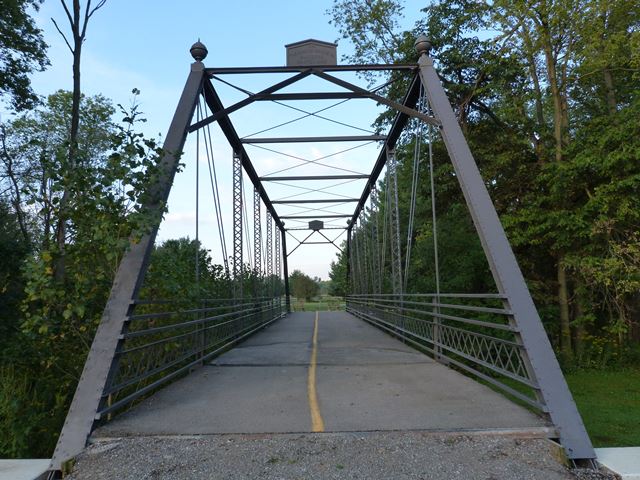We Recommend:
Bach Steel - Experts at historic truss bridge restoration.
BridgeHunter.com Phase 1 is released to the public! - Visit Now
Riverbend Bridge
TR-241 Bridge

Primary Photographer(s): Nathan Holth and Rick McOmber
Bridge Documented: June 24, 2007
Rural: Hancock County, Ohio: United States
1895 By Builder/Contractor: Canton Bridge Company of Canton, Ohio
1972
119.0 Feet (36.3 Meters)
124.0 Feet (37.8 Meters)
15.4 Feet (4.69 Meters)
1 Main Span(s)
3234312

View Information About HSR Ratings
Bridge Documentation
View Archived National Bridge Inventory Report - Has Additional Details and Evaluation
This bridge retains excellent historic integrity, including builder plaques, decorative finials, and original railings. The few alterations present on the bridge are minimal and could be corrected as part of a restoration project. For this reason, the CR-241 Bridge is a significant example of the bridge type that was the standard for the late 19th century, the pin-connected truss bridge. It is a great example of a typical Canton Bridge Company through truss bridge, and its design details are similar to other bridges built by the company. It is noted for its decorative finials, a rare detail on a rural bridge.
This bridge was replaced by a new bridge in 2009. However, thanks in part to efforts by Vern Mesler, the man behind the restorations of the truss bridges in Michigan's Historic Bridge Park, this bridge was relocated a short distance to a park where it stands as an exhibit in the park. Thus the bridge is a noteworthy example of a preserved metal truss bridge in Ohio. The relocation of this bridge was accomplished in an unusual manner. Instead of picking the bridge with one or more cranes, the bridge was moved the way houses are often moved, by rolling it back off the river on wheels.
Information and Findings From Ohio's Historic Bridge InventorySetting/Context The bridge carries a 2 lane road over a stream in a sparsely developed, rural setting. The road provides access to the River Bend Recreation Area from SR 568. Physical Description The 1 span, 124'-long, pin-connected Pratt thru truss bridge is traditionally composed of built-up compression members and eyebar or rod tension members. The upper chords are toe-out channels with cover plate and lacing. The verticals are toe-out channels with lacing. It has A-frame portals complete with ball finials and builder's plaque. There are lattice railings. The bridge has rolled floorbeams supported from the lower-chord pins by U-shaped hangers. The bridge is supported on stone abutments with concrete caps. Integrity Floorbeam hanger connection in end panels has been altered by welded box strengthening, otherwise it has integrity of original design. One of four finials is missing. Summary of Significance The 1895 pin-connected Pratt thru truss bridge is technologically significant as a complete example of its type/design by a prominent Ohio fabricator (Criterion C). It is 1 of 5 identified examples of the
pin-connected Pratt by this builder dating from 1886 to 1910, and the only example of a thru truss (the other 4 are pony trusses). The Canton Bridge Company was established in 1876, but apparently struggled financially and was
reorganized in 1891. One of the original 1891 stockholders was David Hammond, the founder of Canton's larger and better-known fabricator, the Wrought Iron Bridge Company in 1866. The Canton Bridge Company was not an innovator in
Pratt truss-bridge design but was perhaps best known for its successful sales network with offices in major cities from the Northeast to the Midwest with the offices headed by relatives or close associates of David Hammond. In 1901,
the company erected over 800 bridges and claimed to have fabricated 25% of all highway bridges built in Ohio that year. The company remained in operation through at least the mid-1910s. Justification The bridge is one of over 150 extant pin-connected truss bridges dating from 1874 for pony trusses and 1876 for thru trusses. Twenty six predate 1888 and represent the era of experimentation that evolved into standardized designs by about 1888. This example has moderate significance because the genre and the fabricator are so well represented in Ohio. Bridge Considered Historic By Survey: Yes |
![]()
Photo Galleries and Videos: Riverbend Bridge
2007 Bridge Photo-Documentation (Original Location)
A collection of overview and detail photos. This photo gallery contains a combination of Original Size photos and Mobile Optimized photos in a touch-friendly popup viewer.Alternatively, Browse Without Using Viewer
![]()
2015 Additional Unorganized Photos (Current Location)
Original / Full Size PhotosA supplemental collection of photos that are from additional visit(s) to the bridge and have not been organized or captioned. This gallery offers photos in the highest available resolution and file size in a touch-friendly popup viewer.
Alternatively, Browse Without Using Viewer
![]()
2015 Additional Unorganized Photos (Current Location)
Mobile Optimized PhotosA supplemental collection of photos that are from additional visit(s) to the bridge and have not been organized or captioned. This gallery features data-friendly, fast-loading photos in a touch-friendly popup viewer.
Alternatively, Browse Without Using Viewer
![]()
Maps and Links: Riverbend Bridge
Coordinates (Latitude, Longitude):
Search For Additional Bridge Listings:
Bridgehunter.com: View listed bridges within 0.5 miles (0.8 kilometers) of this bridge.
Bridgehunter.com: View listed bridges within 10 miles (16 kilometers) of this bridge.
Additional Maps:
Google Streetview (If Available)
GeoHack (Additional Links and Coordinates)
Apple Maps (Via DuckDuckGo Search)
Apple Maps (Apple devices only)
Android: Open Location In Your Map or GPS App
Flickr Gallery (Find Nearby Photos)
Wikimedia Commons (Find Nearby Photos)
Directions Via Sygic For Android
Directions Via Sygic For iOS and Android Dolphin Browser
USGS National Map (United States Only)
Historical USGS Topo Maps (United States Only)
Historic Aerials (United States Only)
CalTopo Maps (United States Only)



